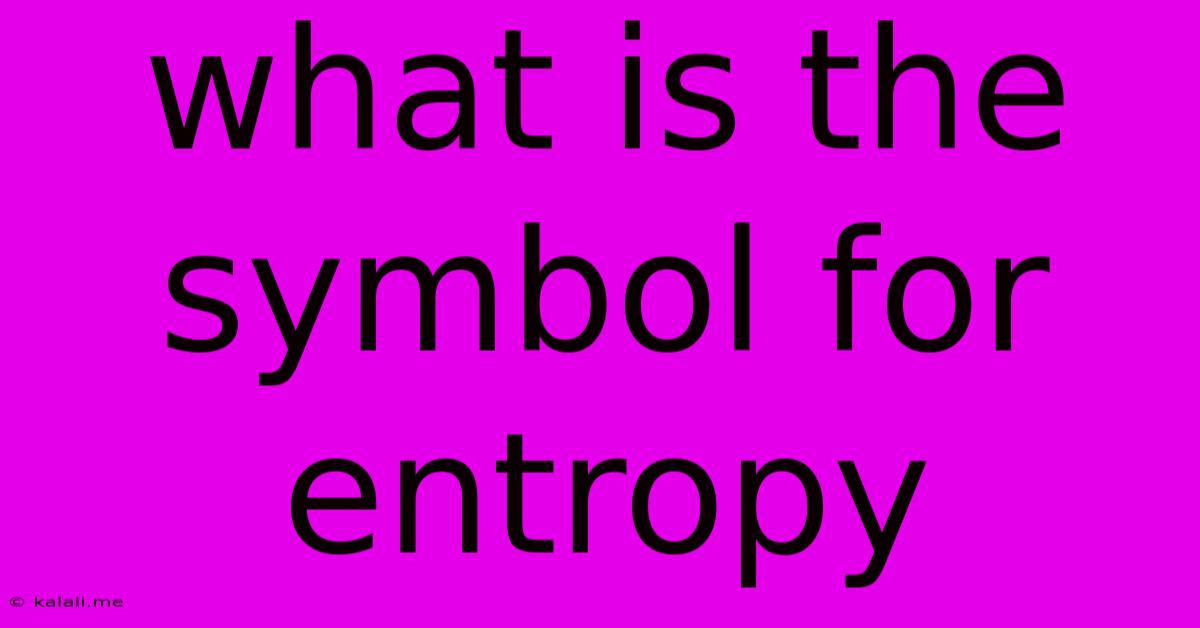What Is The Symbol For Entropy
Kalali
May 09, 2025 · 3 min read

Table of Contents
What is the Symbol for Entropy?
Entropy, a fundamental concept in thermodynamics and information theory, measures the degree of disorder or randomness in a system. Understanding its symbol is key to grasping its significance in various scientific fields. This article will delve into the symbol used to represent entropy, its context within different disciplines, and provide a clear understanding of its meaning.
The most common symbol for entropy is S. This is universally accepted across physics, chemistry, and related fields. While other notations might occasionally appear in specialized contexts, S remains the standard and most readily understood representation. You'll find it prominently used in equations and formulas related to entropy calculations and thermodynamic principles.
The Origin of the Symbol "S" for Entropy
The use of "S" for entropy is attributed to Rudolf Clausius, a pioneering figure in thermodynamics. While the exact reasoning behind his choice isn't explicitly documented, it's widely believed to be linked to the German word "Entropie," which Clausius himself coined. The letter "S" might have been selected due to its phonetic similarity or simply as a convenient and available letter in the scientific notation of the time. Regardless of the exact origin, the adoption of "S" has solidified its place as the standard symbol for entropy.
Entropy in Different Contexts: Beyond Thermodynamics
While thermodynamics is where the concept of entropy first arose, its application extends far beyond. It plays a crucial role in:
-
Statistical Mechanics: Here, entropy is often interpreted as the number of possible microscopic arrangements (microstates) corresponding to a given macroscopic state (macrostate) of a system. The symbol S remains consistent in this interpretation, representing the extensive property related to the multiplicity of microstates.
-
Information Theory: In information theory, entropy measures the uncertainty or randomness associated with a probability distribution. Claude Shannon, the founder of information theory, also employed S to denote entropy, further solidifying its universal recognition. This interpretation highlights the connection between disorder in a physical system and the uncertainty inherent in information.
-
Chemistry: Entropy is a crucial factor in chemical reactions, influencing reaction spontaneity and equilibrium. Here, the symbol S appears in calculations of Gibbs Free Energy (ΔG), a key thermodynamic function that uses entropy to predict the feasibility of a reaction. The standard notation remains consistent across chemical thermodynamics.
Understanding the Symbol in Equations
You'll often encounter the symbol S within various thermodynamic equations, such as:
-
The Second Law of Thermodynamics: This law states that the total entropy of an isolated system can only increase over time or remain constant in ideal cases where the system is in a steady state or undergoing a reversible process. This is often expressed as ΔS ≥ 0.
-
Gibbs Free Energy: The Gibbs Free Energy (ΔG) equation incorporates entropy: ΔG = ΔH - TΔS, where ΔH is the change in enthalpy, T is the absolute temperature, and ΔS is the change in entropy. This equation determines the spontaneity of a process.
In conclusion, while the specific origins might be debated, the symbol S for entropy stands as a universally accepted and crucial element in understanding this fundamental concept across diverse scientific disciplines. Its consistent use ensures clear communication and facilitates the application of entropy principles in various fields, ranging from classical thermodynamics to modern information theory.
Latest Posts
Related Post
Thank you for visiting our website which covers about What Is The Symbol For Entropy . We hope the information provided has been useful to you. Feel free to contact us if you have any questions or need further assistance. See you next time and don't miss to bookmark.